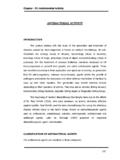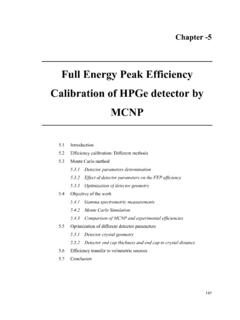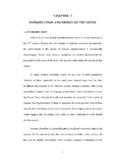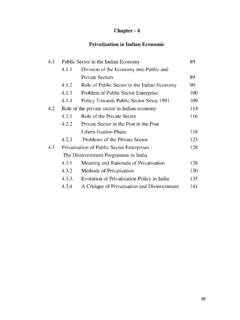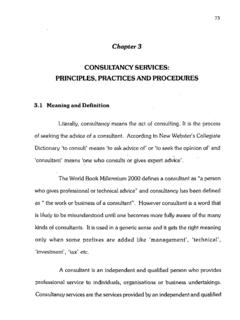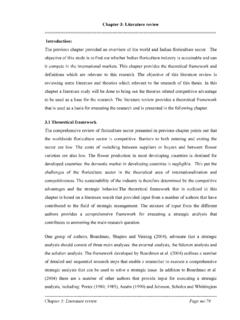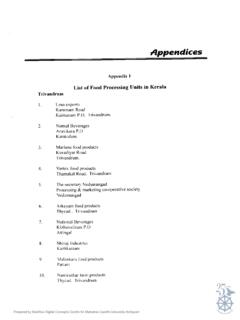Transcription of Chapter 2 Final - Shodhganga
1 19 Chapter 2 Determination of appropriate Sample Size Discussion of this Chapter is on the basis of two of our published papers Importance of the size of sample and its determination in the context of data related to the schools of Guwahati which was published in the Bulletin of the Gauhati University Mathematics Association Vol. 12, 2012 & An investigation on effect of bias on determination of sample size on the basis of data related to the students of schools of Guwahati which was published in the International Journal of Applied Mathematics and Statistical Sciences Vol. 2, Issue 1, 2013 In survey studies, once data are collected, the most important objective of a statistical analysis is to draw inferences about the population using sample information. "How big a sample is required?" is one of the most frequently asked questions by the investigators.
2 If the sample size is not taken properly, conclusions drawn from the investigation may not reflect the real situation for the whole population. So, in this Chapter we have discussed Importance of the size of sample and the method of determination of a sample size along with the procedure of sampling in relation to our study. If there is any effect of bias on determination of sample size Introduction: In spite of the application of scientific method and refinement of research techniques, tools and designs, educational research has not attained the perfection and scientific status of physical sciences. Therefore, there is a great necessity to study properly about different tools and techniques of research methodology. While studying a particular phenomenon, the researchers of this field face a problem at the beginning as 20 what may be the representative sample.
3 Very few research articles are there which deals with the issue of determination of sample size. Sample size calculation for a study, from a population has been shown in many books Cochran (1977), Mark (2005) and Singh and Chaudhury (1985). The aim of the calculation is to determine an adequate sample size which can estimate results for the whole population with a good precision. In other words, one has to draw inference or to generalize about the population from the sample data. The inference to be drawn is related to some parameters of the population such as the mean, standard deviation or some other features like the proportion of an attribute occurring in the population. It is to be noted that a parameter is a descriptive measure of some characteristics of the population whereas if the descriptive measure is computed from the observations in the sample it is called a statistic.
4 Parameter is constant for a population, but the corresponding statistic may vary from sample to sample. Statistical inference generally adopts one of the two techniques, namely, the estimation of population parameters or testing of a hypothesis. The process of obtaining an estimate of the unknown value of a parameter by a statistic is known as estimation [39, 71, 86]. There are two types of estimations viz. point estimation and interval estimation. If the inference about the population is to be drawn on the basis of the sample, the sample must conform to certain criteria: the sample must be representative of the whole population [7, 64]. The question arises as to what is a representative sample and how such a sample can be selected from a population.
5 The computation of the appropriate sample size is generally considered to be one of the most important steps in statistical study. But it is observed that in most of the studies this particular step has been overlooked. The sample size computation must be done appropriately because if the sample size is not appropriate for a particular study then the inference drawn from the sample will not be authentic and it might lead to some wrong conclusions [49]. 21 Again, when we draw inference about parameter from statistic, some kind of error arises. The error which arises due to only a sample being used to estimate the population parameters is termed as sampling error or sampling fluctuations. Whatever may be the degree of cautiousness in selecting sample, there will always be a difference between the parameter and its corresponding estimate.
6 A sample with the smallest sampling error will always be considered a good representative of the population. Bigger samples have lesser sampling errors. When the sample survey becomes the census survey, the sampling error becomes zero. On the other hand, smaller samples may be easier to manage and have less non-sampling error. Handling of bigger samples is more expensive than smaller ones. The non-sampling error increases with the increase in sample size [116]. Fig , : Figures showing relationship between sampling error and sample size 22 There are various approaches for computing the sample size [5, 57, 117]. To determine the appropriate sample size, the basic factors to be considered are the level of precision required by users, the confidence level desired and degree of variability.
7 I) Level of Precision : Sample size is to be determined according to some pre assigned degree of precision . The degree of precision is the margin of permissible error between the estimated value and the population value. In other words, it is the measure of how close an estimate is to the actual characteristic in the population. The level of precision may be termed as sampling error. According to (1977), precision desired may be made by giving the amount of errors that are willing to tolerate in the sample estimates. The difference between the sample statistic and the related population parameter is called the sampling error. It depends on the amount of risk a researcher is willing to accept while using the data to make decisions. It is often expressed in percentage.
8 If the sampling error or margin of error is 5%, and 70% unit in the sample attribute some criteria, then it can be concluded that 65% to 75% of units in the population have attributed that criteria. High level of precision requires larger sample sizes and higher cost to achieve those samples. ii) Confidence level desired : The confidence or risk level is ascertained through the well established probability model called the normal distribution and an associated theorem called the Central Limit theorem. The probability density function (p. d. f) of the normal distribution with parameters and is given by ( )()22212xp xex = < < where, is the mean and is the standard deviation. 23 In general, the normal curve results whenever there are a large number of independent small factors influencing the Final outcome.
9 It is for this reason that many practical distributions, be it the distribution of annual rainfall, the weight at birth of babies, the heights of individuals etc. are all more or less normal, if sufficiently large number of items are included in the population. The significance of the normal curve is much more than this. It can be shown that even when the original population is not normal, if we draw samples of n items from it and obtain the distribution of the sample means, we notice that the distribution of the sample means become more and more normal as the sample size increases. This fact is proved mathematically in the Central Limit theorem. The theorem says that if we take samples of size n from any arbitrary population (with any arbitrary distribution) and calculate x, then sampling distribution of x will approach the normal distribution as the sample size n increases with mean and standard error n x ~ N,n A sample statistic is employed to estimate the population parameter.
10 If more than one sample is drawn from the same population, then all the sample statistics deviate in one way or the other from the population parameter. In the case of large samples, where n>30, the distribution of these sample statistic is a normal distribution. Generally, a question arises that how much should a sample statistic miss the population parameter so that it may be taken as a trustworthy estimate of the parameter. The confidence level tells how confident one can be that the error toleration does not exceed what was planned for in the precision specification. Usually 95% and 99% of probability are taken as the two known degrees of confidence for specifying the interval within which one may ascertain the existence of population parameter ( mean). 95% confidence level means if an investigator takes 100 independent samples from the same population, then 95 out of the 100 samples will provide an estimate within the precision set by him.
